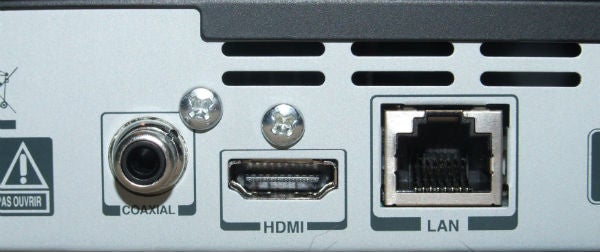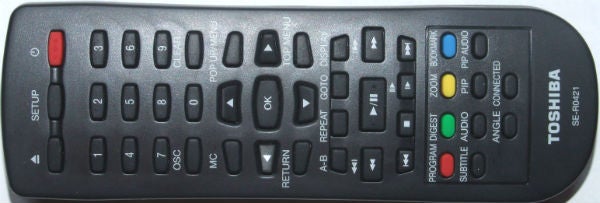Toshiba BDX3300 Review
Toshiba BDX3300
A basic but likeable 2D Blu-ray deck at a great price.

Verdict
Pros
- Good media format support
- Solid pictures
- Low price
- Smart features and DLNA
Cons
- Lightweight build quality
- Basic onscreen presentation
- Fiddly remote
- No DivX playback
Key Specifications
- Review Price: £78.99
- Built-in Wi-Fi
- BBC iPlayer, YouTube, Acetrax and Picasa
- DLNA certified
- Media playback via USB
- Video adjustments
Unlike Panasonic, Samsung or Sony, Toshiba has never been at the forefront of Blu-ray player innovation, instead focusing on decks that do the basics for a very affordable price. But this year the company has upped its game with a four-strong range of players, two of which are equipped with Wi-Fi and smart features. Its big name rivals have been doing this for a while but better late than never – and Toshiba’s big advantage is that it offers all this smart goodness at a much, much lower price.
The BDX3300 is one step down from the range-topping BDX5300, which offers Wi-Fi, online content and 3D Blu-ray playback. The BDX3300 lacks 3D, but in all other respects the two players are the same. Completing the line-up are the 3D-ready BDX4300 and entry-level non-3D BDX1300, both of which lack Wi-Fi and smart features.
![]()
This year’s models have been given a subtle but very welcome cosmetic revamp. You get the same gloss black fascia of previous models but Toshiba has added a fetching silver triangle at the bottom, which makes it much more eye catching. The deck is also much smaller than regular players, with a width of 360mm as opposed to the usual 430mm. That could make it easier to fit into your AV rack, and certainly makes it more appropriate for bedroom use.
Sadly it’s not all good news. The LED display is tiny and attempts to spell words using the seven-segment display, which always looks awkward, plus the row of five buttons next to it have a cheap clicky feel when pressed. In fact the whole thing feels light and flimsy, no doubt a symptom of its budget price tag.

As for connections, there are slim pickings on the rear panel, which only sports HDMI, coaxial digital audio output and an Ethernet port. That’s almost the bare minimum Toshiba could have provided, but to be fair HDMI has rendered old-school analogue sockets like composite, stereo audio, component and multichannel analogue pretty much redundant – more so on a budget player like this.
However, you do get a USB port on the front, which allows you to play music, video and photos from storage devices, as well as providing the memory needed to access BD Live, which isn’t built-in.
The BDX3300’s star attractions are the newly-added online services – BBC iPlayer, YouTube, Acetrax and Picasa. This is a meagre selection compared with the likes of Sony’s Entertainment Network or Samsung’s Smart Hub, yet Toshiba has clearly gone for the apps it feels will add most value, and the inclusion of BBC iPlayer alone is a real boon. YouTube is useful too, and with Acetrax you get a decent selection of movies to choose from (much better than Netflix, anyway).
With these features, Toshiba’s players have certainly gone up in our estimation since last year, but what doesn’t help their cause is the presentation. There’s no fancy dedicated interface for accessing these services – they’re incorporated into the rudimentary Media Center display under an ambiguously titled ‘Connection’ menu, which lists their names in spectacularly dull fashion. It’s a shame this player couldn’t have taken its cue from the more impressive menus on Toshiba’s latest LED TVs – but that may have taken more processing grunt than Toshiba was willing to shove into a budget Blu-ray deck.

We checked it out and BBC iPlayer works well, loading up content fairly quickly and playing programmes like EastEnders in HD without any glitches. YouTube is harder work due to its sluggish navigation but there are no complaints with video quality. Acetrax’s interface looks great, with brightly coloured movie art and a clear layout – in fact, these GUIs put the player’s own to shame.
As well as Blu-ray, DVDs and CDs, the BDX3300 will play digital media formats via USB. We were able to play MPEG-1, MP4, hi-def AVI, MKV (containing 1080p video), XviD, AVCHD, FLAC, AAC, MP3, WAV and JPEG. In fact the only significant absentees are DivX and WMA – otherwise that’s a really impressive range of formats.
Another nice surprise is that the BDX3300 is DLNA certified and can supposedly play these formats from servers on your home network (PCs, NAS drives etc). The player wouldn’t play ball on our network – our Windows 7 laptop appeared in the list but froze after selecting ‘music’ or ‘video’ so we gave up. We didn’t have this trouble with other players.
It’s easy to access these network features thanks to the inclusion of built-in Wi-Fi (802.11b/g/n). We love the fact that Toshiba has put an adapter inside the player rather than making you faff about with an optional dongle. If your internet connection isn’t wireless, no worries – simply hook it up to your router using the Ethernet port.
Elsewhere you’ll find all the Blu-ray player regulars, such as Dolby True HD and DTS HD Master Audio bitstream output and decoding, 1080p upscaling for DVDs and 24Hz output for compatible TVs. Dig into the setup menu and you’ll unearth a couple of other nuggets, such as the Video Adjust menu, which allows you to set the levels of brightness, contrast, hue and saturation in the picture, as well as sharpness presets (Low, Middle and High).
Operation
When you first boot up the player, it helpfully runs through key settings such as the onscreen menu language, resolution and the aspect ratio of your TV. Network setup sadly isn’t part of this process, but the relevant option is easy to find in the setup menu.
But from there on, using the BDX3300 isn’t the blissfully simple experience you get from a Panasonic or Samsung player. For starters, the onscreen menus use a flat colour palette and basic boxes. It all works fine and everything’s easy to follow, yet the onscreen presentation just doesn’t convey a sense of 21st century sophistication as some players do. That applies particularly to the Media Center menu and the online services, which lack the sense of fun of Samsung’s graphics-heavy Smart Hub – here web content is apologetically tucked away in a list.

The remote doesn’t help matters either, with its fiddly, homogenous buttons and a muddled layout that swamps important keys like Media Center and Return. The buttons are also too spongy, requiring quite a forcible press to make the command register. However, there is some salvation in the form of a decent Apple/Android smartphone app that lets you control this player on your device.
Performance
Subjectively the BDX3300’s picture performance is excellent. We fired up Rise of the Planet of the Apes and were highly impressed by the deck’s presentation of the super-detailed CG images, resolving tricky features like fur and wrinkles with pleasing lucidity and keeping edges looking clean.
The picture also looks reasonably cinematic, boasting solid blacks and clear shadow detail, best demonstrated by the visible shading and contours within the apes’ fur. That gives the image a pleasing sense of depth. Colour fidelity is also up to scratch – skin tones look realistic and brighter hues are deep and vibrant, such as the luscious green forests during the movie’s opening aerial shots. Add fluid movement into the mix and you’ve got yourself a decent picture performer.

Just be sure to keep the Sharpness setting set to ‘Low’ as it looks a little too forced in the ‘High’ setting. And annoyingly when using the picture adjustments you can’t instantly see the results of your tweaking because they’re only available through the setup menu, which can’t be accessed without stopping the movie.
From a slightly more objective perspective, the BDX3300 handles the Silicon Optix HQV disc’s test patterns fairly well, locking onto the cadences of the Video and Film Resolution Loss tests quickly and rendering moving diagonal lines on the jaggies test smoothly. However, the camera pan across Raymond James stadium looks juddery and there’s some flicker in the lower seats.
As for disc loading, the deck took 42 seconds to start playing Terminator Salvation’s first piece of video after pressing close on the disc tray, exactly the same sort of time as Panasonic and Samsung’s latest players.
Verdict
The BDX3300’s build quality, onscreen presentation and operation leave a lot to be desired, yet it’s hard not to like a player that gives you valuable online content, built-in Wi-Fi, good format support and DLNA media streaming for just under £80.
In fact, it’s the cheapest new Blu-ray player we’ve encountered that offers Wi-Fi out the box, and for that reason Toshiba deserves plaudits – as well as for its impressive hi-def pictures – yet that lack of build quality and onscreen finesse inevitably feels like a compromise.
Trusted Score
Score in detail
-
Performance 8
-
Design 7
-
Features 7
-
Value 9
Features
| 3D Ready | No |
| BD Player Profile | 2.0 |
| 1080/24p Playback | Yes |
On-Board Decoders
| Dolby TrueHD | Yes |
| DTS Master Audio | Yes |
| Dolby Digital 5.1 | Yes |
| Bitstream Audio Out | Yes |
A/V Ports
| HDMI | 1 |
| Component | No |
| Composite | No |
| S-Video | No |
| Digital Audio Out | Yes (coaxial) |
| Charging/Computer Connection | Yes |
| Ethernet | Yes |
| WiFi | Yes |
| Analogue Audio Out | No |
| SD Memory Card Slot | No |
USB Playback
| MP3 | Yes |
| JPEG | Yes |
| DivX / DivX HD | No |
| MKV | Yes |
Physical Specifications
| Height (Millimeter) | 36mm |
| Width (Millimeter) | 360mm |
| Depth (Millimeter) | 200mm |

